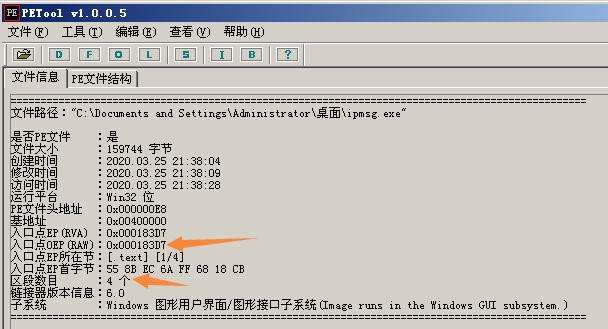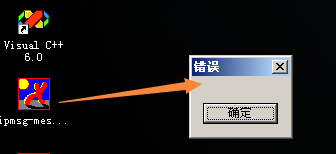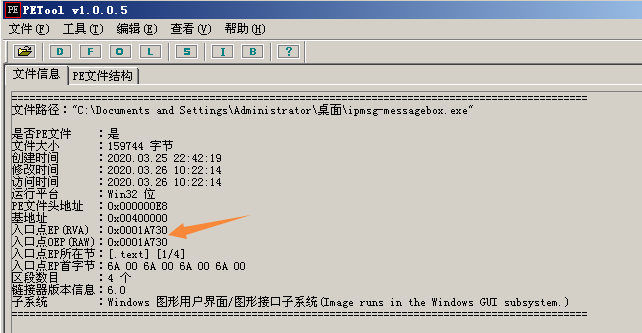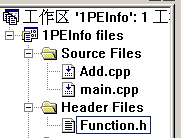逆向笔记——在PE任意一个节中添加代码
备注:添加代码这个原理与加壳、恶意代码的原理类似
基本步骤
1、NoOfSection 数量不要超过 节数量
2、相应节的文件对齐空间要足够代码Code存放
3、找到程序的OEP
3、计算IMAGEBUFF和FILEBUFF之间节的位置转化关系
4、算出JMP <原OEP> CALL〈MessageBoxW〉把位置填入Code中
5、找到节的空白起始区域,存放Code
6、将OEP的值改成Code的RV
手工
1、用PETool查看一下文件信息

2、定位第一个节的插入位置:VirtualSize+VirtualAddress = 00019722 + 1000 = 1A722
可以插在1A722 后的任意空白区域

3、计算 CALL JMP指令后面的4位机器码
X = 真实要跳的地址 - 下一条指令地址
CALL 要跳转到MessageBoxA的地址

JMP 要跳转到 OEP的地址

最后要填进去的代码: 6A 00 6A 00 6A 00 6A 00 E8 AD 60 93 77 E9 95 DC FF FF

改一下OEP为填进去的代码的首地址,0001a730

改完之后运行一下

再用PETool看一下入口点

写代码
工作区的文件结构

Function.h
#include <stdio.h>
#include <windows.h>
#define FUN_AD 0x77D507EA //不同的机器不一样
#define CALL_X 9 //DEMOCODE中E8的地址
#define JMP_Y 14 //DEMOCODE中E9的地址
#define NEXT_X 13 //DEMOCODE中X的下一条指令的地址
#define NEXT_Y 18 //DEMOCODE中Y的下一条指令的地址
/*
unsigned char DEMOCODE[] = {
0X6A,0X00,0X6A,0X00,
0X6A,0X00,0X6A,0X00,
0XE8,0X00,0X00,0X00,
0X00,0XE9,0X00,0X00,
0X00,0X00};
*/
int AddCodeAtSection(unsigned char* FileBuffer,int NoOfSection,unsigned char* Code,unsigned int CodeSize);
unsigned char* FileBuffer(const char* FileName);
int SaveFile(unsigned char* FileBuffer,const char* FileName);
Add.cpp
#include "Function.h"
/*********************************************
在任意节添加代码
输入:FileBuffer NoOfSection Code CodeSize
输出:添加了Code的FileBuffer,运行程序时,先运行Code再转到原来的程序入口
实现步聚: (假定FileBuffer 为Pe格式)
1、NoOfSection 数量不要超过 节数量
2、相应节的文件对齐空间要足够代码Code存放
3、找到程序的OEP
3、计算IMAGEBUFF和FILEBUFF之间节的位置转化关系
4、算出JMP <原OEP> CALL〈MessageBoxW〉把位置填入Code中
5、找到节的空白起始区域,存放Code
6、将OEP的值改成Code的RV
**************************************************/
int AddCodeAtSection(unsigned char* FileBuffer,int NoOfSection,unsigned char* Code,unsigned int CodeSize)
{
PIMAGE_DOS_HEADER pDosHeader;
PIMAGE_NT_HEADERS32 pNt32Header;
PIMAGE_SECTION_HEADER pSectionHeader;
//1、NoOfSection 数量不要超过 节数量
pDosHeader = (PIMAGE_DOS_HEADER)FileBuffer;
pNt32Header = (PIMAGE_NT_HEADERS32)(FileBuffer+pDosHeader->e_lfanew);
if(int(pNt32Header->FileHeader.NumberOfSections) < NoOfSection)
{
printf("NoOfSection Bigger NumberOfSections\n");
return -1;
}
//2、相应节的文件对齐空间要足够代码Code存放
pSectionHeader =(PIMAGE_SECTION_HEADER)(pNt32Header+1);
pSectionHeader = pSectionHeader +(NoOfSection-1);
if(CodeSize > int(pSectionHeader->SizeOfRawData-pSectionHeader->Misc.VirtualSize))
{
printf("No space to write Code\n");
return -2;
}
//3、找到程序的OEP
int OEP = pNt32Header->OptionalHeader.AddressOfEntryPoint;
//3、计算IMAGEBUFF和FILEBUFF之间节的位置转化关系
long InsImageRV = pSectionHeader->VirtualAddress + pSectionHeader->Misc.VirtualSize; //内存中插入的相对位置
long InsPostionRV = pSectionHeader->PointerToRawData + pSectionHeader->Misc.VirtualSize; //文件中的相对位置
long ImageBase = pNt32Header->OptionalHeader.ImageBase; //内存映像总长度
//4、算出JMP <原OEP> CALL〈MessageBoxA〉把位置填入Code中 X = 真实要跳的地址 - 下一条指令地址
int* JMP = (int*)(Code+JMP_Y);
int* CALL = (int*)(Code+CALL_X);
*JMP = (ImageBase+OEP)-(ImageBase+InsImageRV+NEXT_Y);
*CALL = FUN_AD - (ImageBase+InsImageRV+NEXT_X);
//5、找到节的空白起始区域,存放Code
unsigned char* InsCode = FileBuffer+InsPostionRV; //在文件buffer中的插入地址
unsigned int i = 0;
for (i=0;i<CodeSize;i++)
{
InsCode[i] = Code[i];
}
//6、将OEP的值改成Code的RV
pNt32Header->OptionalHeader.AddressOfEntryPoint = pSectionHeader->Misc.VirtualSize + pSectionHeader->VirtualAddress;
return 0;
}
///////////////////////////////////////////////////////////
//将PE文件读到FileBuffer
unsigned char* FileBuffer(const char* FileName)
{
unsigned char* Heap = NULL;
FILE* Stream;
//打开文件
Stream = fopen(FileName,"rb");
//计算文件大小
fseek(Stream,0,SEEK_END);
long FileSize = ftell(Stream);
fseek(Stream,0,SEEK_SET);
//分配堆空间
Heap = (unsigned char*)malloc(sizeof(char)*FileSize);
//将文件拷到堆
fread(Heap,sizeof(char),FileSize,Stream);
fclose(Stream);
return Heap;
}
//////////////////////////////////////////
//将FileBuffer 保存成文件
int SaveFile(unsigned char* FileBuffer,const char* FileName)
{
FILE* Stream;
//打开文件
Stream = fopen(FileName,"wb");
//计算FileBuff大小
PIMAGE_DOS_HEADER pDosHeader;
PIMAGE_NT_HEADERS32 pNt32Header;
PIMAGE_SECTION_HEADER pSecHeader;
pDosHeader = (PIMAGE_DOS_HEADER)FileBuffer;
pNt32Header = (PIMAGE_NT_HEADERS32)(FileBuffer + pDosHeader->e_lfanew);
pSecHeader = (PIMAGE_SECTION_HEADER)(pNt32Header+1);
long FileSize = pNt32Header->OptionalHeader.SizeOfHeaders;
int NumOfSec = pNt32Header->FileHeader.NumberOfSections;
int x;
for(x=0;x<NumOfSec;x++)
{
FileSize += pSecHeader->SizeOfRawData;
pSecHeader++;
}
// 写入文件
fwrite(FileBuffer,sizeof(char),FileSize,Stream);
fclose(Stream);
return 0;
}
main.cpp
/************************************************
*程序说明:在32位PE文件中的任意一个节中添加代码
* 第一个参数为PE文件 第二个参数为第N个节
*
* 时间: 2020 3.29
* Winxp VC++6.0
**************************************************/
#include "Function.h"
unsigned char DEMOCODE[] = {0X6A,0X00,0X6A,0X00,0X6A,0X00,0X6A,0X00,0XE8,0X00,0X00,0X00,0X00,0XE9,0X00,0X00,0X00,0X00};
int main()
{
// PE文件 N个节
unsigned char* FileBuff;
FileBuff = FileBuffer("NOTEPAD.EXE");
int NumOfSection = 1;
if(AddCodeAtSection(FileBuff,NumOfSection,DEMOCODE,sizeof(DEMOCODE)) != 0)
{
free(FileBuff);
return -1;
}
SaveFile(FileBuff,"CopyNOTEPAD.EXE");
free(FileBuff);
return 0;
}



 浙公网安备 33010602011771号
浙公网安备 33010602011771号